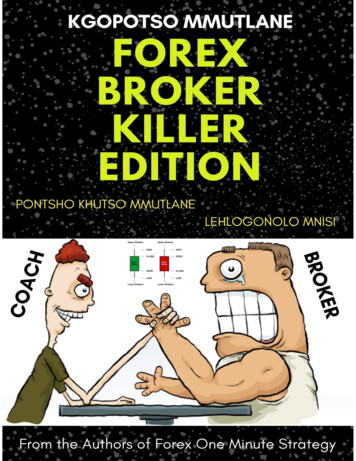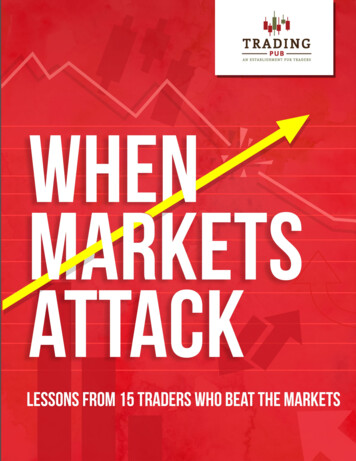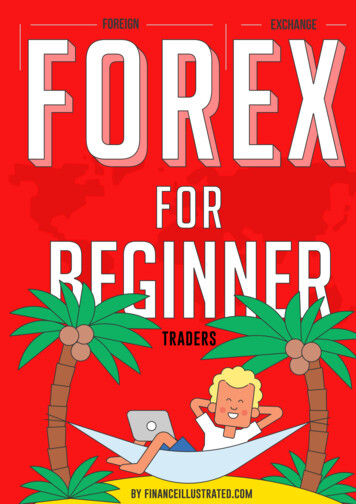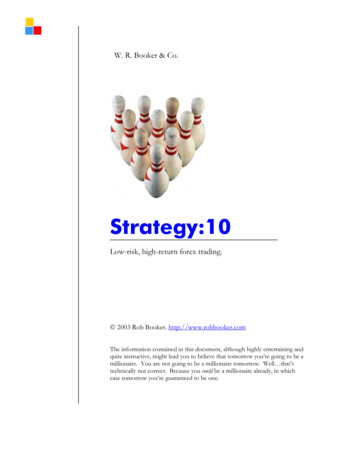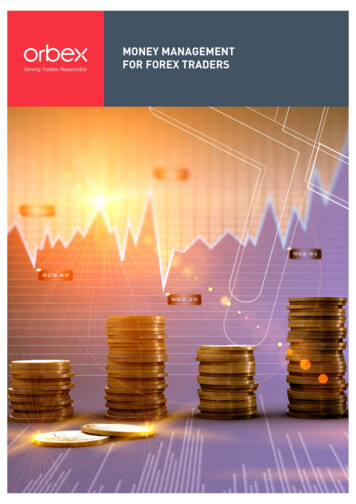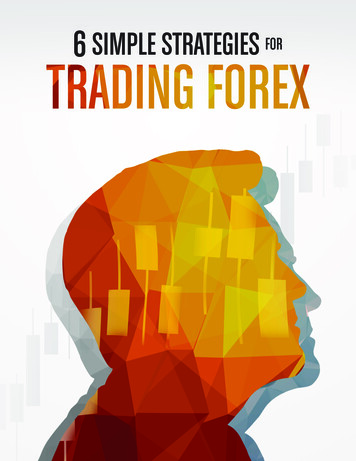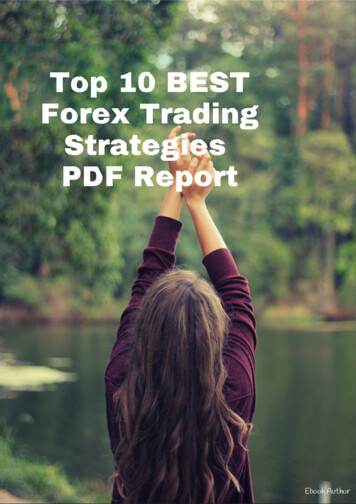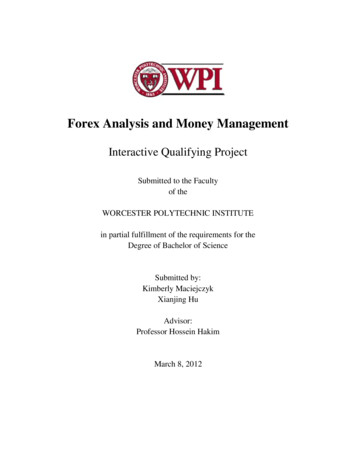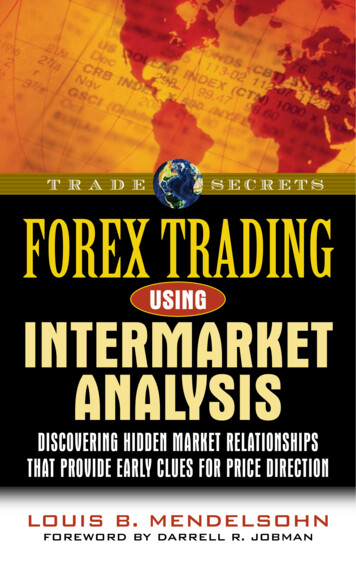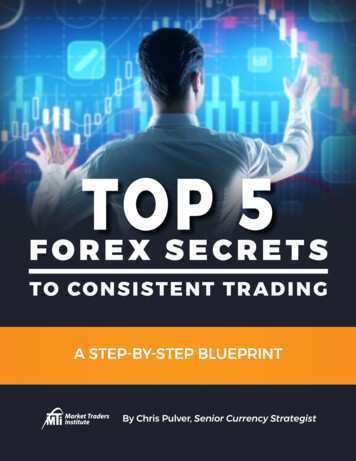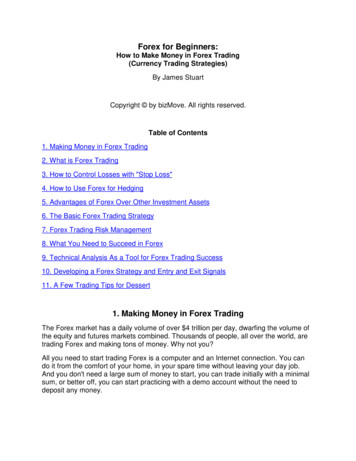
Transcription
Forex for Beginners:How to Make Money in Forex Trading(Currency Trading Strategies)By James StuartCopyright by bizMove. All rights reserved.Table of Contents1. Making Money in Forex Trading2. What is Forex Trading3. How to Control Losses with "Stop Loss"4. How to Use Forex for Hedging5. Advantages of Forex Over Other Investment Assets6. The Basic Forex Trading Strategy7. Forex Trading Risk Management8. What You Need to Succeed in Forex9. Technical Analysis As a Tool for Forex Trading Success10. Developing a Forex Strategy and Entry and Exit Signals11. A Few Trading Tips for Dessert1. Making Money in Forex TradingThe Forex market has a daily volume of over 4 trillion per day, dwarfing the volume ofthe equity and futures markets combined. Thousands of people, all over the world, aretrading Forex and making tons of money. Why not you?All you need to start trading Forex is a computer and an Internet connection. You cando it from the comfort of your home, in your spare time without leaving your day job.And you don't need a large sum of money to start, you can trade initially with a minimalsum, or better off, you can start practicing with a demo account without the need todeposit any money.
Once you consider to start Forex trading, one of the first things you need to do ischoose a broker, choosing a reliable broker is the single most critical factor to Forexsuccess.There are dozens of online brokers out there but your best bet is to go with one of theleaders. Here are 2 online brokers that are reputable and are most suitable forbeginners and pros alike:1. Forex Inc - The best broker for US residents (If the link doesn't work, copy and pastethe following URL into a browser: www.liraz.com/forexinc)2. eToro - accepts worldwide traders except US residents (If the link doesn't work, copyand paste the following URL into a browser: www.liraz.com/etoro).Now I would strongly encourage you to go and visit these broker's sites right now even ifyou are not yet decided whether you want to go into Forex trading. Why? because eachprovides tons of free education materials, videos and best of all a demo account thatallows you to practice Forex trading for free without the need to deposit any money.Simply go to each of these brokers, register for a free demo account and start "trading" by actually practicing and experiencing it firsthand you'll be able to decide whetherForex trading is for you.In any case, before starting to trade for real, it is advisable that you practice with a demoaccount. Once you build some skill and feel more comfortable with the system you canstart trading gradually for real money.Now which of the two brokers you should choose? while both are reputable and reliablethey do have some differences. For starter if you are a US resident you should chooseForex Inc, as eToro does not accept US residents. Here is a summary of the specificadvantages of each of them. Choose based on your personal preferences:Forex Inc (www.liraz.com/forexinc) - is a straightforward website to trade currencies onwith good trading platforms, research and educational tools. It has several differentaccount levels that make it easy for anyone to open an account. Forex Inc is anexcellent broker suitable for beginners and pros alike.eToro (www.liraz.com/etoro) - is a "Social Investment network" - this is an interestingand beneficial concept as it allows you to watch other trades as they are being madeand to copy the trades of the most successful traders. You can also communicate withother traders including the top traders.Go to Top2. What is Forex TradingForeign exchange, popularly known as 'Forex' or 'FX', is the trade of a single currencyfor another at a decided trade price on the over-the-counter (OTC) marketplace. Forex
is definitely the world's most traded market, having an average turnover of more thanUS 4 trillion each day.Compare this to the New York Stock Exchange, that has a daily turnover of aboutUS 70 billion and it is very obvious how the Forex market is definitely the largestfinancial market on the globe.In essence, Forex currency trading is the act of simultaneously purchasing one foreigncurrency whilst selling another, mainly for the purpose of speculation. Foreign currencyvalues increase (appreciate) and drop (depreciate) towards one another as a result ofvariety of factors such as economics and geopolitics. The normal objective of FX tradersis to make money from these types of changes in the value of one foreign currencyagainst another by actively speculating on which way foreign exchange rates are likelyto turn in the future.In contrast to the majority of financial markets, the OTC (over-the-counter) currencymarkets does not have any physical place or main exchange and trades 24-hours everyday via a worldwide system of companies, financial institutions and individuals. Becauseof this, currency rates are continuously rising and falling in value towards one another,providing numerous trading choices.One of the important elements regarding Forex's popularity is the fact that currencytrading markets usually are available 24-hours a day from Sunday evening right throughto Friday night. Buying and selling follows the clock, beginning on Monday morning inWellington, New Zealand, moving on to Asian trade spearheaded from Tokyo andSingapore, ahead of going to London and concluding on Friday evening in New York.The fact that prices are available to deal 24-hours daily makes certain that pricegapping (whenever a price leaps from one level to another with no trading between) isless and makes sure that traders could take a position each time they desire,irrespective of time, even though in reality there are particular 'lull' occasions whenvolumes tend to be below their daily average which could widen market spreads.Forex is a leveraged (or margined) item, which means that you are simply required toput in a small percentage of the full value of your position to set a foreign exchangetrade. Because of this, the chance of profit, or loss, from your primary money outlay isconsiderably greater than in conventional trading.Currencies are designated by three letter symbols. The standard symbols for some ofthe mostcommonly traded currencies are:EUR – EurosUSD – United States dollarCAD – Canadian dollarGBP – British pound
JPY – Japanese YenAUD – Australian dollarCHF – Swiss francForex transactions are quoted in pairs because you are buying one currency whileselling another. The first currency is the base currency and the second currency is thequote currency.The price, or rate, that is quoted is the amount of the second currency required topurchase one unit of the first currency. For example, if EUR/USD has an ask price of1.2327, you can buy one Euro for 1.2327 US dollars.There are so-called majors, for which around 75% of all market operations on Forex areheld: the EUR/USD, GBP/USD, USD/CHF, and USD/JPY. As we see, the US dollar isrepresented in all currency pairs, thus, if a currency pair contains the US dollar, this pairis considered a major currency pair. Pairs which do not include the US dollar are calledcross currency pairs, or cross rates. The following cross rates are the most activelytraded:EUR/CHF euro-francEUR/GBP euro-sterlingEUR/JPY euro-YenGBP/JPY sterling-YenAUD/JPY aussie-YenNZD/JPY kiwi-YenTo give you a taste of what is happening in the Forex arena here are some historicalForex events.One of the most interesting movements in the Forex market involving the British poundtook place in the September 16, 1992. That day is known as Black Wednesday with theBritish Pound posting its biggest fall. It was mostly seen in the GBP/DEM (British Poundvs. the Deutschemark) and the GBP/USD (British Pound vs. the US dollar) currencypairs.The fall of the British pound against the US dollar in the period from November toDecember 1992 constituted 25% (from 2.01 to 1.51 GBP/USD).The general reasons for this "sterling crisis" are said to be the participation of GreatBritain in the European currency system with fixed exchange rate corridors; recentlypassed parliamentary elections; a reduction in the British industrial output; the Bank ofEngland efforts to hold the parity rate for the Deutschemark, as well as a dramaticoutflow of investors. At the same time, due to a profitability slant, the German currencymarket became more attractive than the British one. All in all, the speculators were
rushing to sell pounds for Deutschemarks and for US dollars. The consequences of thiscurrency crisis were as follows: a sharp increase in the British interest rate from 10% to15%, the British Government had to accept pound devaluation and to secede from theEuropean Monetary System. As a result, the pound returned to a floating exchangerate.Another intriguing currency pair is the US dollar vs. the Japanese Yen (USD/JPY). TheUS dollar and Japanese Yen is the third on the list of most traded currency pairs afterthe EUR/USD and GBP/USD. It is traded most actively during sessions in Asia.Movements of this pair are usually smooth; the USD/JPY pair quickly reacts to the riskpeaking of financial markets. From the mid 80's the Yen ratings started rising activelyversus the US Dollar. In the early 90's a prosperous economic development turned intoa standstill in Japan, the unemployment increased; earnings and wages slid as well asthe living standards of the Japanese population. And from the beginning of the year1991, this caused bankruptcies of numerous financial organizations in Japan. As aconsequence, the quotes on the Tokyo Stock Exchange collapsed, a Yen devaluationtook place, thereafter, a new wave of bankruptcies among manufacturing companiesbegan. In 1995 a historical low of the USD/JPY pair was recorded at -79.80.The above started an Asian crisis in the years1997-1998 that led a Yen crash. Itresulted in a tumble of the Yen-US dollar pair from 115 Yens for one US dollar to 150.The global economic crisis touched almost all fields of human activities. Forex currencymarket was no exception. Though, Forex participants (central banks, commercial banks,investment banks, brokers and dealers, pension funds, insurance companies andtransnational companies) were in a difficult position, the Forex market continues tofunction successfully, it is a stable and profitable as never before.The financial crisis of 2007 has led to drastic changes in the world's currencies values.During the crisis, the Yen strengthened most of all against all other currencies. Neitherthe US dollar, nor the euro, but the Yen proved to be the most reliable currencyinstrument for traders. One of the reasons for such strengthening can be attributed tothe fact that traders needed to find a sanctuary amid a monetary chaos.Ask and BidWhen traders want to place an order on the Forex market they should be aware of thecurrency pair as well as the price of this pair. A Forex market price of a currency pair isdenoted by two symbols, Ask and Bid, which have specific digital notations.Ask price is the highest price in the pair’s quotation at which a trader buys the currency,standing first in the abbreviation of the currency pair. Consequently, a trader sells thecurrency standing second.Bid price is the lowest price in the quotation of the currency pair, at which a trader sellsthe currency standing first in the abbreviation of the currency pair. Respectively, a traderbuys the currency standing second.Seem complicated? here's an example:
Let's assume that we have the currency pair of EUR/USD with the quotation of1.3652/1.3655. This means that you can buy 1 euro for 1.3655 dollars or to sell 1 eurofor 1.3652 dollars. The difference between the Bid price and the Ask price is calledspread.The spread is actually the commission of the broker. The Spreads in Forex trading areactually very small compared to currency spreads at banks.A term that you'll see a lot while trading Forex is "pip" and "pips" - a “pip” stands for“Percentage in Point”. A pip is the smallest price movement of a traded currency. It isalso referred to as a “point”. It is very important that you understand what a pip is in theForex trading because you will be using pips in calculating your profits and losses. Formost currencies a pip is 0.0001 or 1/100 of a cent.When a currency moves from a value of 1.2911 to 1.2914, it moved 3 pips. When a piphas a value of 10, you have gained 30.There is an exception for quotations for Japanese Yen against other currencies. Forcurrencies in relation to Japanese Yen a pip is 0.01 or 1 cent.Another term that you'll need to understand in relation to Forex trading is “Lots”. A lot isthe minimal traded amount for each currency transaction. For regular accounts one lotequals 100,000 units of the base currency. However you can also open mini and microaccounts that allow trading in smaller lots.Understanding the Pip Spread - The spread is closely associated with the pip and hasa major importance for you as a trader. As mentioned above, It is the differencebetween the selling and the buying price of a currency pair. It is the difference in the bidand ask price. The ask is the price at which you buy and the bid is the price at whichyou sell.Suppose the EUR/USD is quoted at 1.4502 bid and 1.4505 ask. In this case the spreadis 3 pips. The pip spread is your cost of doing business here. In the case above itmeans you sustain a paper loss equal to 3 pips at the moment you enter the trade. Yourcontract has to appreciate by 3 pips before you break even. The lower the pip spreadthe easier is it for you to profit.Generally the more active and bigger the market, the lower the pip spread. Smaller andmore exotic markets tend to have a higher spread. Most brokers will be offering differentspreads for different currencies. Smaller accounts will generally have higher spreadsthan bigger regular accounts.From the profitability point of view it is important to find a broker offering a lower pipspread, however the low spread is not everything. More important is to choose areputable and reliable broker.Most brokers will allow leverage. Leverage is defined as the use of borrowed capital,such as “margin” allowing the trader to gain access to larger sums of capital. This canheighten profits and losses and should be used wisely.
Here's an example: Trader A has 5000 USD – If Trader A has an account leverage of10:1 and he wishes to use 1000 on one trade as margin, he will have an exposure of 10,000 in base currency ( 1000) 10 x 1000 10,000 (trade value).Trader B has 5000 USD – If Trader B has an account leverage of 100:1 and he wishesto use 1000 on one trade as margin, he will have exposure of 100,000 in basecurrency ( 1000) 100 x 1000 100,000 (trade value).Go to Top3. How to Control Losses with "Stop Loss"Stop loss is a widely used order aiming mainly at limiting the possible losses in case ofnegative market movements.Stop loss is used only with open positions. When the market conditions are notfavorable for a trader and the price has reached the level of the "Stop loss", the deal isclosed automatically. Therefore, Stop loss helps the trader to control losses and in caseof failures to keep safe at least part of his deposit.If a trader does not use Stop loss orders, the position is closed by the broker when thesum of losses is equal to the sum of the deposit.There are 3 types of Stop loss orders: fixed Stop loss, sliding Stop loss and combinedStop loss.Fixed Stop losses are set while opening positions. They cannot be changed until thedeal is closed. Sliding stop losses, on the other hand, can be modified any timedepending on the price movement. Another name for sliding Stop loss is Trailing stop,that can be modified either manually or automatically based on the traders' settings.There are many discussions on whether it is necessary to use Stop losses or not. Sometraders believe that Stop loss is essential in trading, emphasizing the ability of Stoplosses to prevent the loss of the whole deposit. If the price is rapidly moving in adirection which does not correspond to the forecast, a deal that has not been closed intime can result in a significant loss. The opponents of Stop loss believe that this ordercan limit not only losses, but profits as well. Since price movements are oftenunpredictable and unexpected, they can develop in line with the trader’s expectations,though with some periodic bounces crossing the Stop loss line. In this case the positionis closed prematurely with a loss while it could develop into a profit later on.As a rule, the decision on whether to use Stop loss or not depends on the individualstrategy and preferences of a particular trader.Trailing stop is an order which its major function is to act as an automatic maintenanceof an open position with continually shifting of the stop loss level depending on the pricemovement.
A trader may open a bullish position and sets the gap from the current price to trailingstop in pips. When the price goes upwards, the trailing stop follows it automaticallysticking to the set gap. In case that the price goes down, then the trailing stop quoteremains on the spot. In this way, a trader using a trailing stop has an opportunity toderive maximal profit at an ascending price with no regard to the set Take Profit value.Furthermore, a trailing stop is a loss limiter.Here is an example: a trader opens a buy position at the price of 1.3400 and puts thetrailing stop value at 50 pips back, i.e. at 1.3350. In case that the price starts to moveupwards and exceeds the mark of 1.3400, the trailing stop follows it automaticallykeeping the set gap of 50 pips from the current price. That means, if the price touches1370, the trailing stop shifts to 1320. If the price turns down, the price does not changeits position.As to a sell position opening, trailing stop behaves quite in the opposite. The trader setsit a few pips higher. At a price descending motion the trailing stop shifts according to theset size. With the up-going price, the trailing stop does not move.While applying a trailing stop in Forex operations a trader will have to remove stop lossorders manually in line with increases in the trade profit. Trailing stop sets a stop losslevel automatically at the value the trader needs.A trailing stop is mainly used by traders who run trend trading, but can't follow the pricemoves continually. Trailing stop usage is also feasible at intraday trades, when quickreaction to price change is required.Please note that trailing stops work only when the trading terminal is open. Once theterminal is switched off the stop loss is fixed at its current spot.Go to Top4. How to Use Forex for HedgingHedging denotes safety and security. Hedging means the protection of a client's fundsfrom unfavorable currency rate fluctuations. Account funds are fixed at their currentprice through conducting trades on Forex. Thus, hedging helps to ease exposure tocurrency rate changes risks, which helps to prevent the risk of currency ratefluctuations.As a matter of fact, hedging presupposes using one instrument in order to lower the riskrelated to unfavorable market factors impact on the price of another one directlyassociated with it. In most cases, the notion of ‘hedging’ means insurance from currencyprice fluctuations, assets etc. Hedging can also be considered as a type of investmentallowing to minimize price movements risks in the market. The hedging cost should bevalued with regard to the possible losses in the event of not hedging.Hedging types in Forex
One type of hedging is protecting the buyer’s money by lowering the risk of a possibleincrease of an instrument price. Another type is hedging the seller’s money in order tolower a price drop risk.Here's a hedging example: a trader, who imports in a foreign currency, opens a buytrade with the currency of his trading account in advance, and when the real time of thecurrency purchase arrives to his bank, he closes the position. And a trader, who exportsin a foreign currency, opens a sell trade with the currency on his trading accountbeforehand, and at a the real moment of this currency purchase in his bank, he closesit.Go to Top5. Advantages of Forex Over Other Investment Assets1. Simple to comprehend and master - In a Forex trade we deal with just a pair ofcurrencies2. Low Minimum Investment - The Forex market requires less capital to start tradingthan most other markets. The initial investment could go very low, depending on theleverage offered by the broker. This is a great advantage since Forex traders are able tokeep their risk investment to the lowest level. Online Forex brokers offer "mini" and"micro" trading accounts with low minimum account deposit.We're not saying you should open an account with the bare minimum, but it does makeForex trading much more accessible to the average individual who doesn't have a lot ofstart-up trading capital.3. 24 Hour Market - Since the Forex market is worldwide, trading is continuous as longas there is a market open somewhere in the world. Trading starts when the marketsopen in Australia on Sunday evening, and ends after markets close in New York onFriday.4. High Liquidity - Liquidity is the ability of an asset to be converted into cash quicklyand without any price discount. In Forex this means we can move large amounts ofmoney into and out of foreign currency with minimal price movement.5. Low Transaction Cost - In Forex, typically the cost of a transaction is built into theprice. It is called the spread. The spread is the difference between the buying andselling price.6. Leverage - Forex Brokers allow traders to trade the market using leverage. Leverageis the ability to trade more money on the market than what is actually in the trader'saccount. If you were to trade at 50:1 leverage, you could trade 50 on the market forevery 1 that was in your account. This means you could control a trade of 50,000using only 1000 of capital.
7. Profit Potential from Rising and Falling Prices - The Forex market has norestrictions for directional trading. This means, if you think a currency pair is going toincrease in value; you can buy it, or go long. Similarly, if you think it could decrease invalue you can sell it, or go short.8. No one can corner the market - The foreign exchange market is so huge and hasso many participants that no single entity can control the market price for an extendedperiod of time.9. Forex is the largest financial market in the world - The Forex market has a dailyvolume of over 4 trillion. Such a huge amount of a daily volume allows for an excellentprice stability in most market conditions. This means you likely will never have to worryabout slippage as you would when trading stocks or commodities. The price you seequoted on your trading screen is the price you get.10. Market transparency and Instant execution - Market transparency is muchgreater in Forex than in stocks or commodities, this means it is easier to analyze theinner workings of the market and figure out what is driving it. For example, economicreports and news announcements that drive a country’s economic policy are widelyavailable and accessible for anyone interested. Whereas an individual company’saccounting statements are much harder if not impossible to obtain. Instantaneous orderexecution is another great advantage Forex has over other markets. Retail Forextrading is generally done over the internet on all electronic platforms. The Forex markethas no central exchange and was designed to be this way to facilitate large banks andallow for instant execution of transactions, this means no delays for you and extremeease of execution.11. Price movements are highly predictable in the Forex market - Due to its highlyspeculative nature Forex price movements tend to over shoot and then correct back tothe mean. This means there are a number of repetitive patterns that are easilyrecognizable to the trader who is trained in price action analysis. Forex currency pairsgenerally spend more time in very strong up or down trends than other markets, this isalso a huge advantage because it is generally much easier to trade a strongly trendingmarket than a chaotic and consolidating market.12. No constraints on the number or type of transactions - The futures marketsometimes will have what is called a “limit up” or a “limit down” day, this means whenthe price moves beyond a pre-determined daily level traders are restricted from enteringnew positions and are only allowed to exit existing positions if they desire to do so. Thisis meant to control volatility, but because the futures market for currencies follows thespot Forex market the next day at the futures open their sometimes will be large “gaps”or areas where the price has adjusted over night to match the current spot Forex price.Now, if you were holding a futures position over night it is entirely possible that yourstop got gapped around, in which case you would get filled at the next best price, whichoften will be extremely damaging to your trading account. Due to the 24 hour nature ofthe spot Forex market even in extreme market volatility traders generally don’t have toworry about gaps and can almost always get out at the exact price they want.
13. Direct participation, difficult to manipulate or influence - Forex trading operatesin a decentralized online electronic market for its participants: Banks, FCMs, hedgefunds, governments, retail currency conversion houses and high worth net individuals.There is no middleman between the trader and buyer/seller. Investors can interactdirectly with the market maker for pricing on a currency pair. Access is quicker andcosts are lower than in other markets. Large market liquidity makes it very difficult forany one participant to manipulate or influence it.14. Easier market analysis - Countries are more often stable than companies making iteasier to predict their economic direction. Primary factors affecting demand and supplyfor Forex investment are interest rates and economic indicators such as GDP, tradebalances and foreign investment. This and other economic data released regularlydetermines demand and supply for currency pairs.15. Technology frontiers and investing - Technology enables the retail investor theability to make better investment decisions through ready access to economic andpolitical news events, to technical charting software and electronic trading platforms.They also have transparent and safe access to their investment funds in segregatedaccounts so that the safety of their funds is guaranteed.16. Limited Risk - Despite the common perception about Forex being risky, it is easyto limit and reduce the risk if a trader chooses the right strategy. In addition it should bementioned that stops are much easier to control as well, that is why newbies have goodchances to succeed even while doing their first steps as Forex investors and traders.17. No fees or middlemen - There are no commissions when trading on the Forexmarket. The retail brokers in this market are compensated through the bid-ask spread.Businessmen can also spot currency trading which eliminates the middlemen andallows each person to trade directly with the market that is responsible for pricing on acertain currency pair. Not only does this expedite the process, it gives each trader moreoptions and versatility.Go to Top6. The Basic Forex Trading StrategyThe basic Forex strategy that is used by many traders of all experience levels, is TrendFollowing. This strategy is widely followed because of its simplicity to identify and tradeand many times, strong trends can bail you out of an imperfect set of buy and sell rules.A popular trading express is “the trend is your friend.” This expression has stood thetest of time because many traders find it to be a critical building block of a trading plan.Before we delve into the basics of Trend Following, it is important to first explain whytrend trading is a popular strategy used by many new and experienced traders.
Do you have the perfect Forex trading strategy? I have not found it. To me, a perfectstrategy is the one that wins all of the time and has minimal trade drawdown. I hate toburst your bubble but a 100% win ratio strategy does not exist.Therefore, learning how to trade in an imperfect world is very important. Trend followingis a simple way to cover up some strategy imperfections by identifying the strongesttrends in the market.For example, if the market is moving up in a strong trend, it isn’t as important what thestrategy is used to time entries, you simply need to be buying. When you trade in thedirection of the trend, the rest of your trading approach can fall right into place. Thisdoesn't mean that all your trades will be winners. It does mean that you don't have to beexact in your entries and exits once you find a strong trend to trade.Now how do you know when a trend starts and when it is going to end? this is the 64,000 question. Since this is a beginners guide I will not elaborate on the varioustechniques that traders use to identify trends as this is beyond the scope of this book. Iwill however touch on several techniques in later chapters but note that these will bejust in an introduction level without going too much deeper.Any trader either a newbie or a pro should develop his own style of trading. There areseveral trading styles that you can adopt. You will choose your style based on yourpersonality and financial capacities.Many traders make the mistake of adopting a trading style that is unnatural for them. Atrader may adopt one of the following two main trading styles: Day Trading andIntraweek trading. Let's discuss each of them;Day TradingDay trading on Forex means that one or few trades are conducted within one tradingday. As a rule, the time intervals between the opening or the closing of trades may takefrom several minutes up to several hours.Despite some difficulties of day-trading, t
7. Forex Trading Risk Management . 8. What You Need to Succeed in Forex 9. Technical Analysis As a Tool for Forex Trading Success . 10. Developing a Forex Strategy and Entry and Exit Signals 11. A Few Trading Tips for Dessert . 1. Making Money in Forex Trading . The Forex market has a daily volume of over 4

